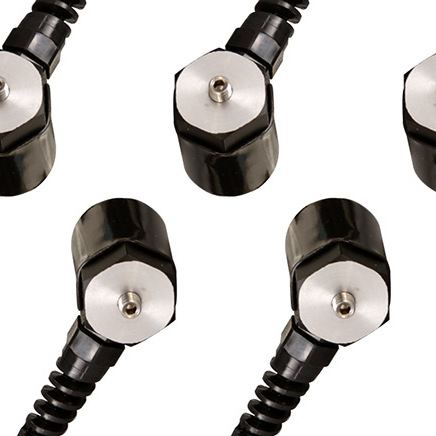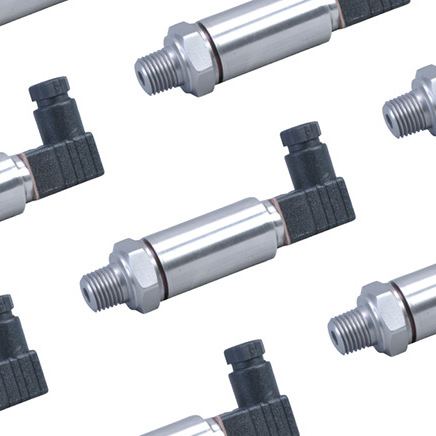Load Cell Meters
Load cell meters, which are also known as load cell indicators or displays, are devices that provide visual representations of the load cell’s output readings. They serve as the interface between the load cell and the user, allowing one to monitor and interpret the measured force or weight.The load cell meter connects directly to the strain gauge. It takes the load cell signal and converts it into a displayed value. These digital meters are mounted on a panel from where they receive the power and the signals to display the measurement values.
Load cell meters also have some additional functionalities available, such as:
- Analog Functionality – wherein the device is capable of producing analog outputs (such as current output or voltage output) proportional to the input signal.
- Data Interface Functionality – which allows the user to collect information for further analysis.
- Set Point Functionality – which allows users to activate alarms or simple control functions through the present input values.
Following are some of the most important parameters based on which a load meter or strain meter is selected:
Type of Display
There are two fundamental types of displays available – numeric and alphanumeric. A numeric display is capable of displaying only numbers, while the alphanumeric display can show both numbers and letters.
Lighting Technology
LED (Light Emitting Diodes) or LCD (Liquid Crystal Display) lighting technologies are generally used in the digital display.
An LED display uses diodes to light up the segments. This type of display appears bright in the dark.
An LCD usually displays black digits on a light gray screen. This type of display consumes less power as compared to LEDs, but are difficult to see in the dark without backlighting.
Features
A load cell meter also comes with additional capabilities and features/functionalities, including:
- Setpoint Setup: This feature allows users to set control limits for weighing parameters. Once the load cell reaches or exceeds the set-point values, the unit sends an ‘OFF’ signal. Similarly, an ‘ON’ signal is sent when the value drops below the set-point value.
- Alarms: Built-in audio or visual alarms to indicate once the set point values are reached.
- Additional Channels: The display meter features more than one channel to receive and record signal values from multiple sources.
- USB Port: A USB port makes it easy to connect the display meter to a computer for data analysis.
- Signal Input Type
Load Cell Controllers
Load cell controllers, which are also referred to as signal conditioners or amplifiers, play a crucial role in the processing and conditioning of the electrical signals produced by load cells – ensuring that the load cell’s output signal is amplified, filtered, and linearized to provide accurate and reliable measurements. A load cell controller can measure physical values – such as load, torque, weight, pressure, or strain – from a single load cell or from multiple load cells.The load cell has an excitation circuit as well as a measuring circuit. The excitation voltage is fed to the load cell for its best performance. The output from the load cell is then relayed back to the load cell controller where it is processed and stored.
The device can take measurements in real-time using the digital display interface. The features of a load cell controller vary from product to product, where the price is the determining factor. Powerful load cells are capable of communicating with peripheral devices like a computer or a remote display unit. They can also help to store the values on the computer’s storage drive for the technician to review them later.
Most load cell controllers offer many mounting options as they can mount on a desk, wall, or panel.
Load Cells with Remote Display
To accurately read and process the load cell values, displays form an essential part of the weighing system. While display units are mostly integrated to the weighing scales, it is not always possible to read the values directly at the location of the weighing.For example, in the case of vehicle scales, shipping and picking scales, concrete mixing plants, and industrial scales, the electronics used for the physical measurements are often located at a greater distance from the physical parameter under measurement.
This is where remote displays are useful. They serve as secondary displays to the already integrated displays used to read the weighing results. Remote display essentially consists of a large 7-segment display with approximately 100 mm digit display height to offer an impressive view even from a long distance. They are easy to set up and require simply plugging into the scale’s RS-232 port.
Remote displays can be easily mounted on desktop, wall, or panel. Additionally, these displays make it easy to connect your computer to the scale and capture the results for further assessment/analysis.
Limitations
But it is also important to note that remote displays can yield unsatisfactory results if the distance between the scale and the remote display is too large (approx. 10 feet away from the converter output terminals). This is because wires and connectors have their resistance. The longer the cable runs, the more uncertain the results are going to be. Additionally, signals are prone to disturbance due to the noise in an industrial setting. In such error-prone conditions, readings on a remote display might not remain accurate for a longer duration.To avoid this, an instrumentation amplifier is usually employed to amplify the signals form a distant load cell via long cable runs. The amplifier provides clean differential voltage to display accurate measurement values on the remote display.
- What is a Load Cell?
- Types of Load Cells
- Selecting a Load Cell
- FAQ
- Installing a Load Cell
- How to Wire a Load Cell?
- Troubleshooting
- Amplifiers for Load Cells
- Data Loggers for Load Cells
- Load Cell Meter
- Load Cell Controller
- Signal Conditioners
- Weighing Trucks, Trains, and Aircraft
- Dynamic Load Measurement
- Testing Load Tolerance in Cables
- Critical Component in X-ray Laser


